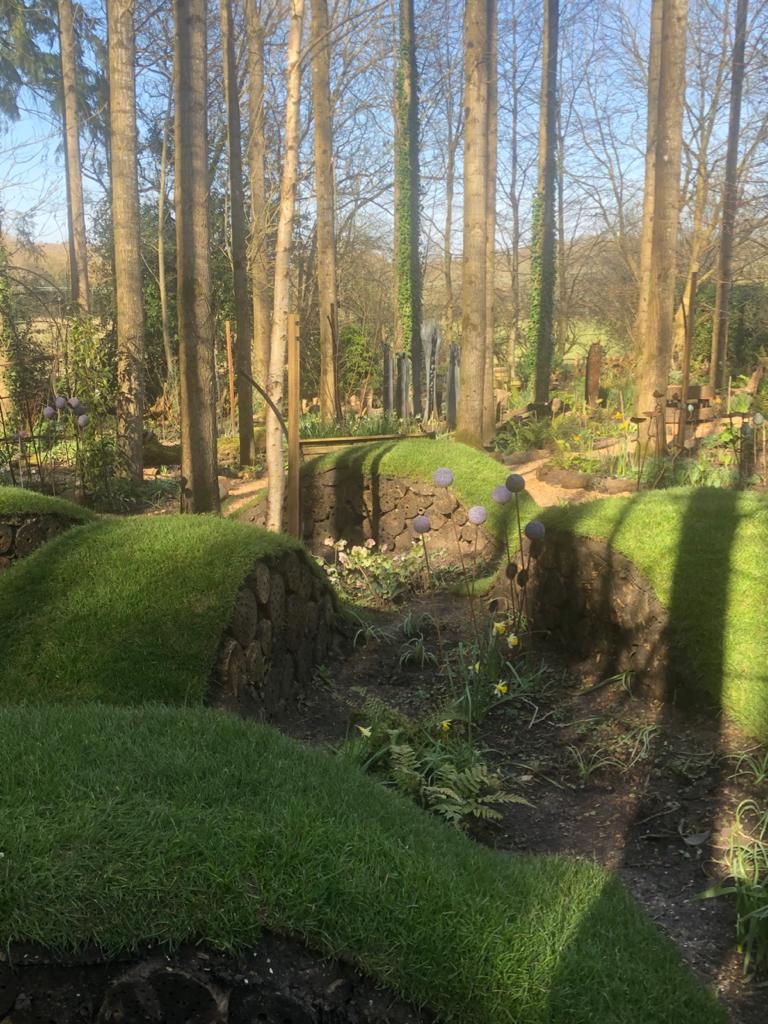An accidental evolution: The Old Vicarage, West Sussex

Stepping through the gate of the Old Vicarage in Washington, West Sussex it’s impossible to agree with owner Meryl Walters assertion that she is no gardener.
“The garden is really the result of many people’s talents combined and the need to mitigate a series of problems,” she says of the four acres with its woodland hemmed lawn that falls gently away from the back of the former Victorian vicarage.
“We bought the house in 1992 and at that time it had a full view of the A24, hundreds of rabbits and a few horses that would occasionally run amok. At some time part of the grounds had also been sold to the local school and we had full view of that too,” explains Meryl. “So our first job was to protect and screen the garden and reduce as much of the noise from the busy road as we could.”
Working with the National Trust and the village 3,000 trees, mostly English natives including oak, ash, yew and blackthorn, were planted as a barrier to the road. A woodland of one metre high poplar whips was also planted in a swath at the bottom of the sloping lawn. Today, those poplars stand almost 30 metres tall and in the summer, when the trees are in full leaf, the combined woodlands make a good job of blocking out the worst of the road noise.
The poplars also provide a wonderfully shady woodland garden to explore with a stream gently running through it, a stumpery and a quite spectacular tree house.
“It seemed like a great idea to have a tree house but with the poplars slender and still growing we couldn’t attach anything to them so we built a platform. But it looked pretty ugly so we added plywood sides – uglier still – and eventually clad the structure in half rounds of chestnut to simulate the poplars.”
With the building complete the family started having fun; in went a wood burning stove, comfy chairs, and gorgeous stained glass bug windows that throw sun dappled colour across the walls and floor.
- The treehouse
- Comfy chairs for tree dwellers
- One of the colourful bug windows
- Undulating turf covered log piles
- Stepping stones in the woodland
- The fern bridge
Throughout the garden are quirky corners and beautiful structures that punctuate the planting. Two metal deer permanently graze the lawn, a new fern bridge with softly sinuous metal fronds crosses the stream, and unusual gabion blocks form an archway for insects and bugs in the wood and a base for the Italianate pavilion. There’s a huge rocking chair on which to rest and survey the view, a Japanese Tea House, an ornamental pond, and petrified wood mounted on slate.
“But there was nowhere sunny to sit,” says Meryl. “The back of the house faces north so we set about creating more of a garden on the sunny frontage of the house.”
Meryl designed a conservatory – the perfect place for tea on a National Garden Scheme open day – and landscaped the space to keep car parking separate. And, at the front of the house, taking pride of place, a beautiful flame of steel created by the same blacksmith who has crafted the seating, railings and fern bridge throughout the garden. It’s clear to see that Meryl’s career in interior design has influenced the garden, her eye for shape, colour, form and structure shines through.
“But nothing has been planned,” she insists. “We slashed back an invasion of brambles looking for our boundary to the side of the house and unearthed hidden fruit trees, so we planted an orchard. We added a greenhouse close by and then another, an asparagus patch, cold frames, raised beds and some beehives. We’re currently planting willows.”
Bryan, the family’s housekeeper, brought his Asian roots to the garden and inspired the creation of the Japanese garden, despite the fact that he comes from the tropical Philippines. His natural green fingers have taken over all aspects of the green houses where, amongst a large variety of things, the bananas and tropical plants are overwintered to go into the “hot bed” in summer.
But it’s more than a garden of structure and form, it’s a garden for all seasons too. It begins with snowdrops and every type of spring bulb to follow, there are 2,000 tulips (annually lifted and replaced), annuals, pots, herbaceous borders, and tumbling roses. It’s little surprise then that in its tenth year of opening for the National Garden Scheme in 2019 The Old Vicarage donated a record-breaking amount from opening its gates.
- The sloping lawn leading down to the woodland
- Meryl with Bryan and Poppy
- Spring colour
“I love sharing the garden,” says Meryl. “And being part of the National Garden Scheme keeps me on my toes, keeps me raising the bar, dreaming up new ideas. The garden is fun and what I love best is that it pays everyone back.”
“It’s an accidental evolution,” Meryl insists. “I’m not a gardener but I have a beautiful garden.”
Meryl hopes to open again soon for the National Garden Scheme and when the gates are unlocked on this quirky, quintessentially English garden, make sure to be in the queue.
For more information about The Old Vicarage click here
If you enjoyed this content please consider making a donation to help us continue to support our nursing and health beneficiaries.



























